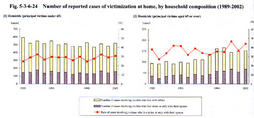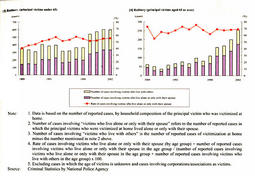| Previous Next Index Image Index Year Selection | |
|
|
5 Trends in victimization of elderly people, by household composition Fig. 5-3-6-24 shows the number of cases in which elderly people were victimized at home, by household composition and by comparison between elderly victims (aged 65 or over in this subsection) and other victims.
As for homicide, among victims under 65, the number of cases involving victims who live with people other than or in addition to their spouse (hereinafter referred to as "victims who live with others") has been larger than that involving victims who live alone or only with their spouse. The rate of cases involving victims who live alone or only with their spouse has remained almost flat within the range between 24.3% and 32.0%. Among victims aged 65 or over, both the number of cases involving victims who live alone or only with their spouse and that involving victims who live with others have been increasing. The rate of cases involving victims who live alone or only with their spouse has been fluctuating within the range between 26.7% and 46.5%. As shown in Chapter 2, Section 2-2, homicide is frequently committed against the perpetrator's relatives, and therefore living with others does not always contribute to decreasing the number of homicide cases. As for robbery, among victims under 65, the number of cases involving victims who live alone or only with their spouse has been almost the same as that involving victims who live with others. The rate of cases involving victims who live alone or only with their spouse has been rising slightly, up from 40% to a level over 50%. On the other hand, the number of cases involving victims aged 65 or over has been rising since 1998, and the number of cases involving victims who live with others and that involving victims who live alone or only with their spouse has increased 3.0-fold and 3.2-fold from 1997 to 2002 respectively. The rate of cases involving victims who live alone or only with their spouse has remained flat at a high level between 61.8% and 75.5%. This suggests that elderly people who live alone or only with their spouse are being targeted more frequently for robbery. Fig. 5-3-6-24 Number of reported cases of victimization at home, by household composition (1989-2002) |

